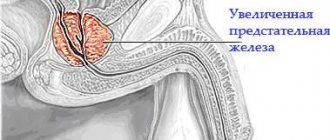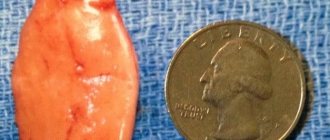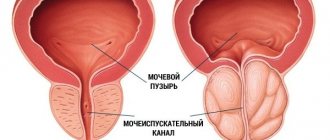- home
- general surgery
- Adrenal tumor
- Aldosteroma
For a free written consultation, in order to determine the type of adrenal tumor, its localization to the main structures of the organ and indications for surgery, as well as choosing the correct surgical treatment tactics, you can send me a complete description of the abdominal ultrasound, CT or MSCT data with contrast, results of hormonal examination (in daily urine - metanephrines and catecholamines, in blood - cortisol, aldosterone), examination by an endocrinologist, indicate age and main complaints. Then I will be able to give a more accurate answer to your situation.
Primary hyperaldosteronism (Conn's syndrome)
Fig.1. The location and blood supply of the adrenal gland is normal
Primary hyperaldosteronism (PHA) is a disease in which excess aldosterone production is autonomous, independent of the influence of various regulatory factors - in contrast to the secondary increase in aldosterone secretion that accompanies a number of diseases. Primary hyperaldosteronism is considered as an independent nosological form, while secondary hyperaldosteronism causes only a number of specific symptoms in diseases of the kidneys, liver and other organs of various etiologies and pathogenesis. There are no exact data on the frequency of PHA, since many patients do not come to the attention of endocrinologists. However, such patients make up a significant portion of those suffering from arterial hypertension.
Etiology and pathogenesis of aldosteroma - primary hyperaldosteronism
Morphologically, the substrate of primary hyperaldosteronism is an adrenal tumor, less commonly hyperplasia of the adrenal cortex. According to J.Conn (1955,1964), single adenomas (aldosteromas) occur in 70-90% of patients, multiple ones - in 10-15%, adrenal hyperplasia - 9%. In general, tumor lesions of the adrenal glands, as the cause of primary hyperaldosteronism, are observed in 85% of cases, and in 2-6% of patients they are malignant.
According to modern concepts, the prevalence of primary hyperaldosteronism (PHA) in patients with hypertension is 10-17% and up to 30% in secondary (symptomatic) hypertension. Aldosterone-producing adenoma is detected in 10-15% of all forms of PHA. It should be noted that in case of accidentally detected tumors, the incidence of aldosteroma is extremely low and does not exceed 1%, however, the largest number of unjustified adrenalectomies is associated with overdiagnosis of aldosteroma.
Primary hyperaldosteronism occurs mainly in adults. Aldosteroma in most cases is a single, clearly defined encapsulated tumor weighing 1-3 g, with a diameter of up to 3 cm. On a section, it is ocher-yellow, ocher-golden-yellow in color with a smooth surface.
Patient preparation rules
venous blood
Standard preparation conditions (unless otherwise determined by the doctor):
2 weeks in advance Coordinate with the doctor the intake of: drugs from licorice root, diuretics, antihypertensive drugs, oral contraceptives.
For 3 days, meals without salt restriction. For 8 hours, withstand fasting, eliminate fatty foods. You can drink water. Be in an upright position (standing, sitting) for 2 hours. Sit at the manipulation table for 5 minutes. Notes:
attached.
ARS.pdf
You can add this study to your cart on this page
Clinical picture of aldosteroma - primary hyperaldosteronism
Clinical signs of primary hyperaldosteronism are represented by three main syndromes: cardiovascular (hypertensive), neuromuscular and renal.
Cardiovascular (hypertensive) syndrome of aldosteroma - primary hyperaldosteronism
Arterial hypertension is one of the most typical symptoms of primary hyperaldosteronism. It is observed in almost all patients with primary hyperaldosteronism, and in some cases it may even be the only clinical manifestation of this disease (Conn J. et al., 1964). Arterial hypertension is usually permanent. However, in some patients the increase in blood pressure takes the form of crises; Transient arterial hypertension is also possible.
Blood pressure levels range from moderately elevated numbers (150-160 and 90-100 mmHg) to very high (250-280 and 130-140 mmHg. The pathophysiological basis of such hypertension is sodium retention in tissues and hypervolemia, intimal edema, decreased vascular lumen, significant increase in peripheral resistance.In addition, the high sodium content in the walls of blood vessels and the depletion of cells in potassium increase the sensitivity of the vessels to the effects of pressor factors.
Neuromuscular syndrome of primary hyperaldosteronism
Disorders of the neuromuscular system in patients are caused mainly by hypokalemia, changes in the concentration gradients of extra- and intracellular potassium, potassium-sodium coefficient, intracellular acidosis, and ultimately - dystrophic changes in muscle and nervous tissues. Patients, as a rule, complain of pronounced muscle weakness, which is observed in 70% of cases. The degree of myasthenia gravis varies from moderate fatigue and fatigue to pseudoparalytic conditions. Myasthenia gravis can either be widespread or affect a specific muscle group, most often the lower extremities. Chvostek's paresthesias have been described (Weinberger M. et al., 1979)
Renal aldosteroma syndrome - primary hyperaldosteronism
Hypokalemia and hypernatremia are also the main cause of the development of kalipenic nephropathy, which is manifested by a decrease in the concentrating ability of the kidneys, polyuria, isohyposthenuria, nocturia, increased thirst and polydipsia.
Functions of aldosterone in the body
As a result of the action of aldosterone on the distal tubules of the kidneys, the tubular reabsorption of sodium ions increases, the content of sodium and extracellular fluid in the body increases, the secretion of potassium and hydrogen ions by the kidneys increases, and the sensitivity of vascular smooth muscles to vasoconstrictor agents increases.
The main functions of aldosterone:
- maintaining electrolyte balance;
- regulation of blood pressure;
- regulation of ion transport in the sweat, salivary glands and intestines;
- maintaining the volume of extracellular fluid in the body.
Normal secretion of aldosterone depends on many factors - the concentration of potassium, sodium and magnesium in the plasma, the activity of the renin-angiotensin system, the state of renal blood flow, as well as the content of angiotensin and ACTH in the body (a hormone that increases the sensitivity of the adrenal cortex to substances that activate the production of aldosterone).
With age, hormone levels decrease.
Aldosterone levels in blood plasma:
- newborns (0–6 days): 50–1020 pg/ml;
- 1–3 weeks: 60–1790 pg/ml;
- children under one year: 70–990 pg/ml;
- children 1–3 years old: 70–930 pg/ml;
- children under 11 years of age: 40–440 pg/ml;
- children under 15 years of age: 40–310 pg/ml;
- adults (in a horizontal body position): 17.6–230.2 pg/ml;
- adults (upright): 25.2–392 pg/ml.
In women, normal aldosterone concentrations may be slightly higher than in men.
Diagnostic algorithm for identifying aldosteroma - primary hyperaldosteronism
Currently, the aldosterone-renin ratio (ARR) is recommended as a screening method for PHA. Numerous studies confirm the diagnostic superiority of ARS in comparison with separately used methods for determining the level of aldosterone or potassium (both indicators have low sensitivity), renin (low specificity).
A prerequisite for diagnosing PHA is the presence of arterial hypertension (AH) in the patient! In case of adrenal incidentaloma in the absence of hypertension, the determination of ARS is not indicated!
The reliability of ARS as the main laboratory test in the diagnosis of PHA, even limited by strict indications, is still debatable.
This is due to the poor reproducibility of this test, as well as to many factors influencing the CA/ARP ratio - drug intake, patient position, time of blood sampling, salt diet, etc. It is mandatory to discontinue all medications (especially mineralcorticoid receptor antagonists and diuretics) that affect the level of aldosterone and plasma renin activity for 4-6 weeks before the study. To correct hypertension during the diagnostic period, alpha-blockers (doxazosin) and non-dihydropyridine calcium channel blockers (verapamil) are recommended. Despite the fact that APC is a widely used test for the primary diagnosis of PHA, there are significant variations in the critical range of diagnostic values, associated both with the use of different units of measurement and with the lack of standardization of the test, which makes it difficult to formulate uniform diagnostic values for PHA.
Who needs examination
Aldosterone is a hormone produced by the adrenal cortex. This hormone takes part in the regulation of potassium-sodium balance, which is responsible for blood volume and blood pressure levels. An aldosterone test is most often prescribed for high blood pressure when antihypertensive therapy does not have the desired effect.
Indications for testing aldosterone levels:
- High blood pressure.
- Reduced potassium concentration in the blood.
- A person experiences an orthostatic hypotensive state (dizziness with a sudden change in posture).
- Insufficiency of adrenal function. Symptoms: fatigue, asthenia, low blood pressure, sudden weight loss, skin hyperpigmentation, gastrointestinal disorders, addiction to excessively salty foods.
A blood test for aldosterone is prescribed by the attending physician (therapist, endocrinologist, nephrologist). Additionally, a blood test for renin is required, since these are interrelated hormones.
To get advice, you need to make an appointment at the clinic with a specialist or therapist.
Treatment of aldosteroma - primary hyperaldosteronism
Treatment of primary hyperaldosteronism caused by an aldosterone-secreting adenoma of the cortex of one of the adrenal glands is surgical. Medication methods are indicated for mild forms of the disease caused by bilateral idiopathic hyperplasia of the adrenal cortex, as well as during the period of preparing patients for surgery.
Surgical treatment of primary hyperaldosteronism caused by aldosteroma is the only radical treatment method and consists of removing the aldosteroma (partial with organ preservation or unilateral adrenalectomy).
Watch a video of operations for adrenal tumors performed by Professor K.V. Puchkov. You can visit the website “Video of operations of the best surgeons in the world.”
Patients, as a rule, do not require special preoperative preparation or hormone replacement therapy in the early postoperative period. The choice of surgical approach, operation, anesthesia and intensive care in patients with aldosteroma do not have any specific features.
In case of aldosteronism caused by diffuse nodular hyperplasia of the adrenal cortex, the indications for surgery have not yet been clearly developed and the existing opinions of surgeons are ambiguous.
How to get tested
The analysis requires venous blood taken strictly on an empty stomach. The most suitable time for the procedure is from 8 to 11 am. Repeated studies should be carried out at the same time of day.
The main method for studying biomaterial is the enzyme immunoassay method (ELISA). Aldosterone in blood serum is detected by adding a labeled reagent to it. It binds only to this hormone and at the same time colors the entire test substance. The level of aldosterone is determined by the intensity of blood serum staining.
Decreased aldosterone levels
With aldosterone deficiency in the kidneys, sodium concentration decreases, potassium excretion slows down, and the mechanism of ion transport through tissues is disrupted. As a result, the blood supply to the brain and peripheral tissues is disrupted, the tone of smooth muscle muscles is reduced, and the vasomotor center is inhibited.
Hypoaldosteronism requires lifelong treatment; medication and limited potassium intake allow compensation for the disease.
Hypoaldosteronism is a complex of changes in the body caused by a decrease in the secretion of aldosterone. There are primary and secondary hypoaldosteronism.
Primary hypoaldosteronism is most often congenital in nature, its first manifestations are observed in infants. It is based on a hereditary disorder of aldosterone biosynthesis, in which sodium loss and arterial hypotension increase renin production.
The disease is manifested by electrolyte disturbances, dehydration, and vomiting. The primary form of hypoaldosteronism tends to spontaneously remit with age.
Secondary hypoaldosteronism, which manifests itself in adolescence or adulthood, is based on a defect in aldosterone biosynthesis associated with insufficient production of renin by the kidneys or reduced renin activity. This form of hypoaldosteronism often accompanies diabetes mellitus or chronic nephritis. The development of the disease can also be facilitated by long-term use of heparin, cyclosporine, indomethacin, angiotensin receptor blockers, and ACE inhibitors.
Symptoms of secondary hypoaldosteronism:
- weakness;
- intermittent fever;
- orthostatic hypotension;
- cardiac arrhythmia;
- bradycardia;
- fainting;
- decreased potency.
Sometimes hypoaldosteronism is asymptomatic, in which case it is usually an incidental diagnostic finding during examination for another reason.
There are also congenital isolated (primary isolated) and acquired hypoaldosteronism.







